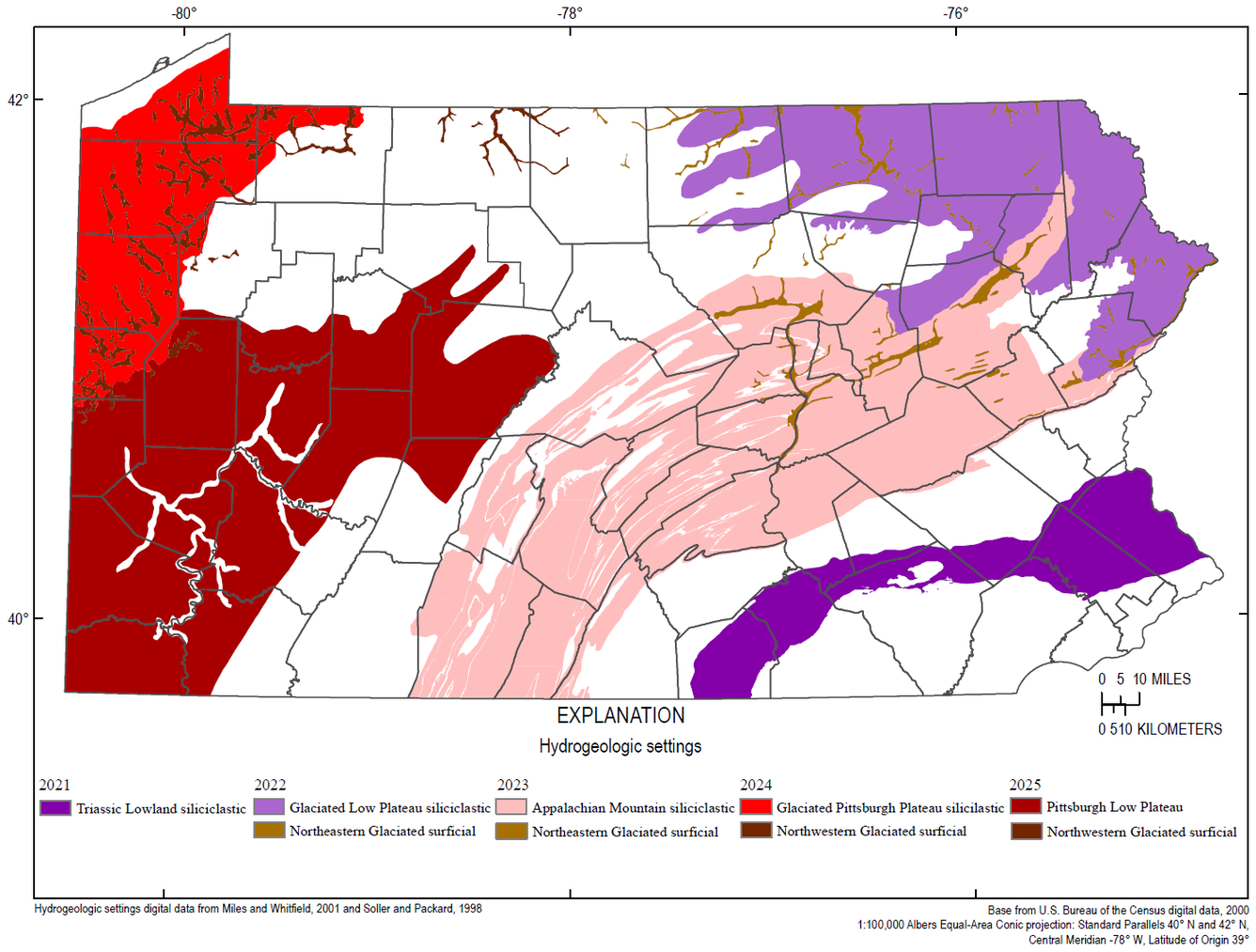USGS Documents Sampling Results for Pesticides in Groundwater
New geonarrative, in cooperation with the Pennsylvania Department of Agriculture
USGS annually samples domestic groundwater wells to characterize pesticides, nutrients, and radon in agricultural areas, in cooperation with the Pennsylvania Department of Agriculture. Beginning in 2021, samples for major ions, trace elements, bacteria, and isotopes will also be collected. A subset of wells will be sampled for per- and polyfluoroalkyl substances (PFAS), emerging industrial contaminants in Pennsylvania groundwaters.
This project began in 2003 to further the understanding of pesticide concentrations in different hydrogeologic settings. Pesticides sampling by USGS in Pennsylvania began in carbonate aquifers in the southeastern part of the state in the 1980s. Assessments of pesticides in groundwater were conducted in the Potomac, Delaware, Lower Susquehanna, Allegheny, and Monongahela River basins during the first round of the National Water Quality Assessment (NAWQA ) studies. Findings are summarized in a Previous Studies Archive.

Pesticides and Water Quality
Agricultural Activities and Pesticides
Estimated Annual Agricultural Pesticide Use for Counties of the Conterminous United States, 2013-17 (ver. 2.0, May 2020) Estimated Annual Agricultural Pesticide Use for Counties of the Conterminous United States, 2013-17 (ver. 2.0, May 2020)
Estimated Annual Agricultural Pesticide Use by Major Crop or Crop Group for States of the Conterminous United States, 1992-2017 (ver. 2.0, May 2020) Estimated Annual Agricultural Pesticide Use by Major Crop or Crop Group for States of the Conterminous United States, 1992-2017 (ver. 2.0, May 2020)
Multiple lines of evidence point to pesticides as stressors affecting invertebrate communities in small streams in five United States regions Multiple lines of evidence point to pesticides as stressors affecting invertebrate communities in small streams in five United States regions
Pesticides in US Rivers: Regional differences in use, occurrence, and environmental toxicity, 2013 to 2017 Pesticides in US Rivers: Regional differences in use, occurrence, and environmental toxicity, 2013 to 2017
Environmental and anthropogenic drivers of contaminants in agricultural watersheds with implications for land management Environmental and anthropogenic drivers of contaminants in agricultural watersheds with implications for land management
Pesticides and pesticide degradates in groundwater used for public supply across the United States: Occurrence and human-health context Pesticides and pesticide degradates in groundwater used for public supply across the United States: Occurrence and human-health context
Evaluating changes in matrix based, recovery-adjusted concentrations in paired data for pesticides in groundwater Evaluating changes in matrix based, recovery-adjusted concentrations in paired data for pesticides in groundwater
Factors affecting groundwater quality in the Valley and Ridge aquifers, eastern United States, 1993-2002 Factors affecting groundwater quality in the Valley and Ridge aquifers, eastern United States, 1993-2002
Pesticides in ground water in selected agricultural land-use areas and hydrogeologic settings in Pennsylvania, 2003-07 Pesticides in ground water in selected agricultural land-use areas and hydrogeologic settings in Pennsylvania, 2003-07
Factors affecting water quality in selected carbonate aquifers in the United States, 1993-2005 Factors affecting water quality in selected carbonate aquifers in the United States, 1993-2005
Ground-water-quality data in Pennsylvania: A compilation of computerized [electronic] databases, 1979-2004 Ground-water-quality data in Pennsylvania: A compilation of computerized [electronic] databases, 1979-2004
Water Quality in the Delaware River Basin, Pennsylvania, New Jersey, New York, and Delaware, 1998-2001 Water Quality in the Delaware River Basin, Pennsylvania, New Jersey, New York, and Delaware, 1998-2001
Pesticide compounds in streamwater in the Delaware River Basin, December 1998-August 2001 Pesticide compounds in streamwater in the Delaware River Basin, December 1998-August 2001
Summary of and factors affecting pesticide concentrations in streams and shallow wells of the lower Susquehanna River basin, Pennsylvania and Maryland, 1993-95 Summary of and factors affecting pesticide concentrations in streams and shallow wells of the lower Susquehanna River basin, Pennsylvania and Maryland, 1993-95
Monitoring for Pesticides in Pennsylvania's Groundwater Monitoring for Pesticides in Pennsylvania's Groundwater
USGS annually samples domestic groundwater wells to characterize pesticides, nutrients, and radon in agricultural areas, in cooperation with the Pennsylvania Department of Agriculture. Beginning in 2021, samples for major ions, trace elements, bacteria, and isotopes will also be collected. A subset of wells will be sampled for per- and polyfluoroalkyl substances (PFAS), emerging industrial contaminants in Pennsylvania groundwaters.
This project began in 2003 to further the understanding of pesticide concentrations in different hydrogeologic settings. Pesticides sampling by USGS in Pennsylvania began in carbonate aquifers in the southeastern part of the state in the 1980s. Assessments of pesticides in groundwater were conducted in the Potomac, Delaware, Lower Susquehanna, Allegheny, and Monongahela River basins during the first round of the National Water Quality Assessment (NAWQA ) studies. Findings are summarized in a Previous Studies Archive.







